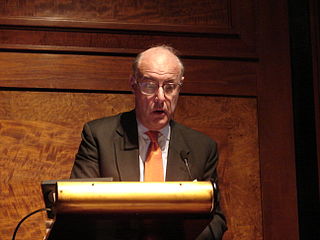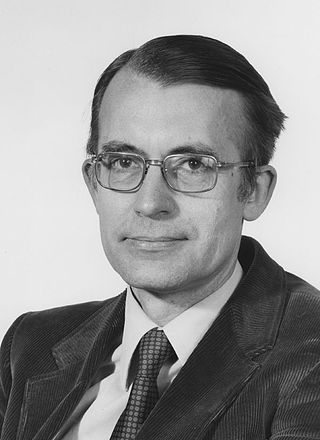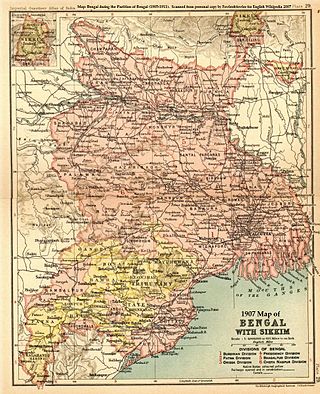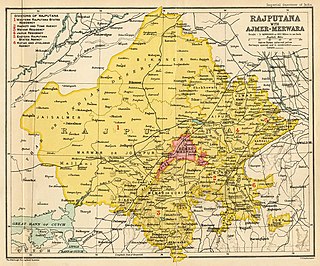Related Research Articles

India is the second most populated country in the world with one-sixth of the world's population. According to official estimates in 2022, India's population stood at over 1.4 billion.

Sir David Nicholas Cannadine is a British author and historian who specialises in modern history, Britain and the history of business and philanthropy. He is currently the Dodge Professor of History at Princeton University, a visiting professor of history at Oxford University, and the editor of the Oxford Dictionary of National Biography. He has been the president of the British Academy since 2017, the UK's national academy for the humanities and social sciences. He also serves as the chairman of the trustees of the National Portrait Gallery in London and vice-chair of the editorial board of Past & Present.

The Bengal Famine of 1770 was a famine that struck Bengal and Bihar between 1769 and 1770 and affected some 30 million people. It occurred during a period of dual governance in Bengal. This existed after the East India Company had been granted the diwani, or the right to collect revenue in Bengal by the Mughal emperor in Delhi, but before it had wrested the nizamat, or control of civil administration, which continued to lie with the Mughal governor, the Nawab of Bengal Nazm ud Daula (1765-72).

The Dominion of India, officially the Union of India, was an independent dominion in the British Commonwealth of Nations existing between 15 August 1947 and 26 January 1950. Until its independence, India had been ruled as an informal empire by the United Kingdom. The empire, also called the Indian Empire, consisted of regions, collectively called British India, that were directly administered by the British Crown, and regions, called the princely states, that were ruled by Indian princes under a system of paramountcy. The Dominion of India was formalised by the passage of the Indian Independence Act 1947, which also formalised an independent Dominion of Pakistan—comprising the regions of British India that are today Pakistan and Bangladesh. The Dominion of India remained "India" in common parlance but was geographically reduced. Under the Act, the British government relinquished all responsibility for administering its former territories. The government also revoked its treaty rights with the rulers of the princely states and advised them to join in a political union with India or Pakistan. Accordingly, the British monarch's regional title, "Emperor of India," was abandoned.
Kingsley Davis was an internationally recognized American sociologist and demographer. He was identified by the American Philosophical Society as one of the most outstanding social scientists of the twentieth century, and was a Hoover Institution senior research fellow.
Alan Donald James Macfarlane is an anthropologist and historian, and a Professor Emeritus of King's College, Cambridge. He is the author or editor of 20 books and numerous articles on the anthropology and history of England, Nepal, Japan and China. He has focused on comparative study of the origins and nature of the modern world. In recent years he has become increasingly interested in the use of visual material in teaching and research. He is a Fellow of the British Academy and the Royal Historical Society.
Jack A. Goldstone is an American sociologist, political scientist, and historian, specializing in studies of social movements, revolutions, political demography, and the 'Rise of the West' in world history. He is an author or editor of 13 books and over 150 research articles. He is recognized as one of the leading authorities on the study of revolutions and long-term social change. His work has made foundational contributions to the fields of cliodynamics, economic history and political demography. He was the first scholar to describe in detail and document the long-term cyclical relationship between global population cycles and cycles of political rebellion and revolution. He was also a core member of the "California school" in world history, which replaced the standard view of a dynamic West and stagnant East with a ‘late divergence’ model in which Eastern and Western civilizations underwent similar political and economic cycles until the 18th century, when Europe achieved the technical breakthroughs of industrialization. He is also one of the founding fathers of the emerging field of political demography, studying the impact of local, regional, and global population trends on international security and national politics.

Sir Edward Anthony Wrigley was a British historical demographer. Wrigley and Peter Laslett co-founded the Cambridge Group for the History of Population and Social Structure in 1964.

Demographic history is the reconstructed record of human population in the past. Given the lack of population records prior to the 1950s, there are many gaps in our record of demographic history. Historical demographers must make do with estimates, models and extrapolations. For the demographic methodology, see historical demography.
Sir Keith Vivian Thomas is a Welsh historian of the early modern world based at Oxford University. He is best known as the author of Religion and the Decline of Magic and Man and the Natural World. From 1986 to 2000, he was president of Corpus Christi College, Oxford.

After the Indian Rebellion of 1857, the British Government took over the administration to establish the British Raj. The British Raj was the period of British rule on the Indian subcontinent between 1757 and 1947, for around 200 years of British occupation. The system of governance was instituted in 1858 when the rule of the East India Company was transferred to the Crown in the person of Queen Victoria.

The Orissa famine of 1866 affected the east coast of India from Madras northwards, an area covering 180,000 miles and containing a population of 47,500,000; the impact of the famine, however, was greatest in the region of Orissa, now Odisha, which at that time was quite isolated from the rest of India. In Odisha, the total number who died as a result of the famine was at least a million, roughly one third of the population.

The timeline of major famines in India during British rule covers major famines on the Indian subcontinent from 1765 to 1947. The famines included here occurred both in the princely states, British India and Indian territories independent of British rule such as the Maratha Empire.

The Rajputana famine of 1869 affected an area of 296,000 square miles (770,000 km2) and a population of 44,500,000, primarily in the princely states of Rajputana, India, and the British territory of Ajmer. Other areas affected included Gujarat, the North Deccan districts, the Jubbalpore division of the Central Provinces and Berar, the Agra and Bundelkhand division of the United Provinces, and the Hissar division of the Punjab.

The Bihar famine of 1873–1874 was a famine in British India that followed a drought in the province of Bihar, the neighboring provinces of Bengal, the North-Western Provinces and Oudh. It affected an area of 140,000 square kilometres (54,000 sq mi) and a population of 21.5 million. The relief effort—organized by Sir Richard Temple, the newly appointed Lieutenant-Governor of Bengal—was one of the success stories of the famine relief in British India; there was little or no mortality during the famine.

The Great Famine of 1876–1878 was a famine in India under Crown rule. It began in 1876 after an intense drought resulted in crop failure in the Deccan Plateau. It affected south and Southwestern India—the British-administered presidencies of Madras and Bombay, and the princely states of Mysore and Hyderabad—for a period of two years. In 1877, famine came to affect regions northward, including parts of the Central Provinces and the North-Western Provinces, and a small area in the Punjab. The famine ultimately affected an area of 670,000 square kilometres (257,000 sq mi) and caused distress to a population totalling 58,500,000. The excess mortality in the famine has been estimated in a range whose low end is 5.6 million human fatalities, high end 9.6 million fatalities, and a careful modern demographic estimate 8.2 million fatalities. The famine is also known as the Southern India famine of 1876–1878 and the Madras famine of 1877.

The Indian famine of 1896–1897 was a famine that began in Bundelkhand, India, early in 1896 and spread to many parts of the country, including the United Provinces, the Central Provinces and Berar, Bihar, parts of the Bombay and Madras presidencies, and parts of the Punjab; in addition, the princely states of Rajputana, Central India Agency, and Hyderabad were affected. All in all, during the two years, the famine affected an area of 307,000 square miles (800,000 km2) and a population of 69.5 million. Although relief was offered throughout the famine-stricken regions in accordance with the Provisional Famine Code of 1883, the mortality, both from starvation and accompanying epidemics, was very high: approximately one million people are thought to have died.

The Indian famine of 1899–1900 began with the failure of the summer monsoons in 1899 over Western and Central India and, during the next year, affected an area of 476,000 square miles (1,230,000 km2) and a population of 59.5 million. The famine was acute in the Central Provinces and Berar, the Bombay Presidency, the minor province of Ajmer-Merwara, and the Hissar District of the Punjab; it also caused great distress in the princely states of the Rajputana Agency, the Central India Agency, Hyderabad and the Kathiawar Agency. In addition, small areas of the Bengal Presidency, the Madras Presidency and the North-Western Provinces were acutely afflicted by the famine.

Eric Peter Kaufmann is a Canadian professor of politics at Birkbeck, University of London. He is a specialist on Orangeism in Northern Ireland, nationalism, and political and religious demography. He has authored, co-authored, and edited multiple books on these subjects.
Lynda Nead is a British curator and art historian. She is currently the Pevsner Chair of the History of Art at Birkbeck, University of London. Nead's work studies British art, media, culture and often focuses on gender. Nead is a fellow of the British Academy, the Royal Historical Society and of the Academia Europaea.
References
- ↑ LSE- Tim Dyson
- ↑ Moosvi, Shireen (2019), "Book review: Tim Dyson, A Population History of India: From the First Modern People to the Present Day", Studies in People's History, 6: 91–93, doi: 10.1177/2348448919834799
- ↑ Population and development review- book review, doi: 10.1111/padr.12242
- ↑ "Review-The Demographic Transition", The Actuary
- ↑ Foreign affairs review-Twenty-First Century India, January 2005